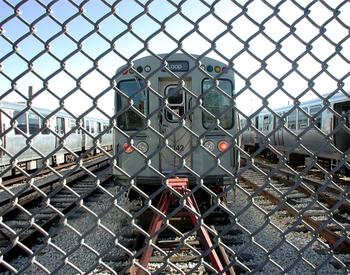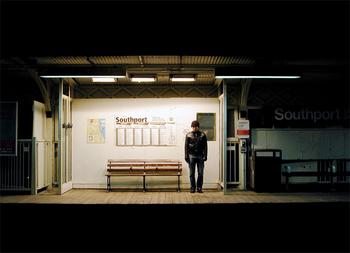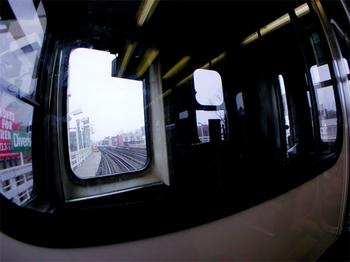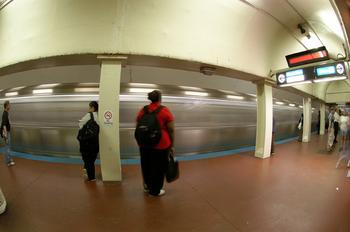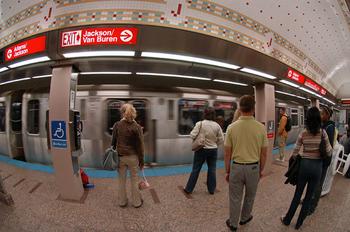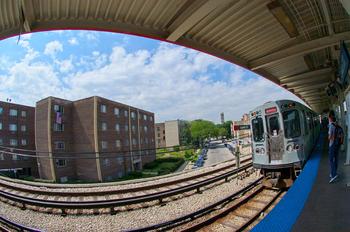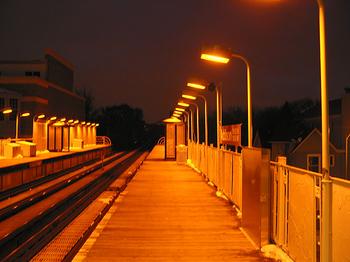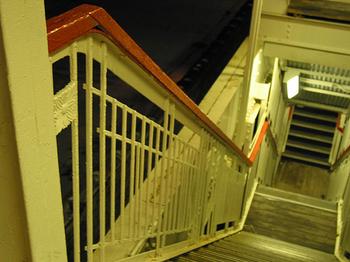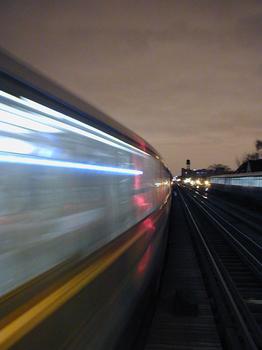One evening during the hectic weeks that followed the World Trade Center attacks, I happened to overhear an unusual conversation on the El about what seemed to be a potential transportation disaster. The passengers were heading southbound on the Red Line during morning rush hour. At the Sheridan stop, commuters blitzed the cars, and when the "Doors Closing" announcement chimed, everyone scrambled for purchase with typical disregard for whoever's face their armpits would smother. In other words, it was rush hour as usual. However, when the train lurched forward, everyone noticed something unusual -- the doors hadn't closed. Those who barged in at the last minute now hung out of the car, regretting their aggressiveness.
Fortunately the car soon stopped, the doors closed, and no one was injured. The incident, however, reminds us that the El, though safer than most forms of transportation -- notably cars -- is certainly not without its dangers.
On January 9, 1976, though the skies in Chicago were sunny, the city was still sweatered in snow from the night before. It was one of those brilliant winter days that require sunglasses. Unfortunately, the operator of the CTA train that plowed into the rear end of another parked train wasn't wearing his. Blaming the sun's reflection on the snow, the operator failed to brake in time to avoid slamming into the train ahead, resulting in the death of one man and injuring 400 others. But that wasn't the entire story -- officials admitted that the signaling system, designed to alert a motorman if he neared another train, apparently malfunctioned.
Under pressure -- doubts had already surfaced concerning the El's safety after four accidents in 1974, including one that injured 224 people -- CTA authorities embarked on an extensive renovation of the safety system, spending $25 million to install fail-safe signaling equipment.
But it is impossible to install fail-safe operators.
One year later the CTA endured the most deadly collision in its history. The intersection of Lake and Wabash is among the Loop's busiest. Cars speed through a forest of I-beams while pedestrians throng the sidewalks at all hours of the day; the roar of the El and the bite of the lake wind only compound the chaos. At 5:30 p.m. on February 4, 1977, there were probably expressions of relief on the commuters' faces as a storm that had dumped four inches of snow on the city was just beginning to clear up.
Then, as a westbound Green Line train rounded the arc of the Loop, rush-hour commotion was silenced by a metallic thunderclap followed by a sickening crackle as three El cars jackknifed off the tracks.
"People fell out of the train and the train fell on top of them," said a witness sitting in a nearby restaurant -- a restaurant that was soon turned into a makeshift infirmary. "We tried to pull the people out from under the train. There were a lot of dead people."
Investigations ultimately placed the blame on Stephen A. Martin, 34, a motorman with eight years of experience. Martin pulled away from the Randolph/Wabash station and, unbelievably, failed to notice the stopped Brown Line train ahead. Though the train's speed was less than 15 mph, Martin -- and this is truly stupefying -- continued to apply power after the collision until the coupling broke between the first and second cars, forcing the rear of the first car and the front of the second car into the air and finally off the tracks. The third car followed in the plunge while the fourth dangled from the tracks, still attached to the rest of the train. 11 people were killed, 180 injured.
It's baffling how such a complex signaling system failed to prevent the catastrophe. In 1977, when the train received what was called a restrictive signal, the operator had a few seconds to stop before the brakes would automatically engage. However, once they had engaged, the driver could proceed "on-sight" at speeds less than 15 m.p.h. Mr. Martin must have stopped at the signal, then proceeded "on-sight" until he blindly rammed the train ahead.
The moral of the story is that no amount of technological safeguards can prevent human error. But disastrous mistakes can be reduced by hiring the right people to begin with -- Martin was found with four joints in his pocket and had a dismal safety record -- and thoroughly training them.
But the recent cuts in CTA funding may jeopardize the integrity of training and the quality of CTA employees. Sound like an unreasonable conclusion? Think about it. Every entity has a budget, be it a non-profit organization, a corporation or a string quartet. When that budget shrinks, the members of that entity feel its effects. In the business world, the recent recession has stagnated economic growth and narrowed profit margins. My sister-in-law, who works at Kraft, will see a reduction in her pension benefits unless she continues to work past retirement age. Although they awarded her a small bonus this year, last year she received nothing. In straitening budgets, employees who may be slated to get a raise do not get one. In short, when the budget is tight, employees are overworked and under-compensated. This isn't a safe combination when those employees operate hurling metal capsules filled with commuters.
In fact, as recent as February 4, 2004, when a Purple Line train collided with a Brown Line train near the Merchandise Mart, the driver stated that he had been distracted by what he thought was a car wreck below. The official NTSB report attributed the distraction to fatigue. The motorman had been working as a switchman from 10 p.m. -- 6 a.m. and then as a motorman from 6 a.m. -- 10 a.m. After taking a short nap, he returned to work. The accident occurred at 5:46 p.m., approximately 20 hours after his work day had started. Since he was working two different positions, CTA's overtime restrictions did not apply, even though both motorman and switchman are "safety sensitive positions."
To battle its budget cuts, CTA threatens to cut service -- an inconvenience the public vociferously protests. But, when it comes down to it, service cuts are exactly that: mere inconveniences. What we should be complaining about are a tight budget's attendant changes in CTA's management of its employees. No amount of technological wizardry can prevent a tired, underpaid employee from making a mistake. And sometimes those mistakes are far more than inconveniences -- they are disasters.
Photo Essay: The CTA





